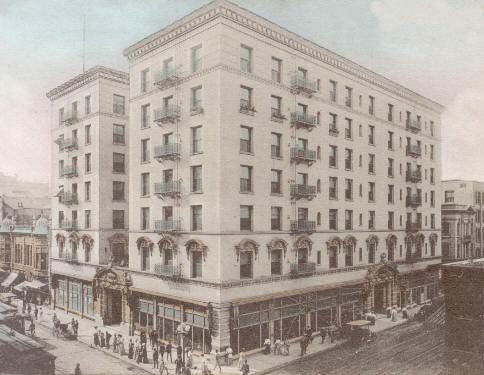
A Visit to Old Los
Angeles
6. Spring Street (Part
2).
by
Brent C. Dickerson
Copyright © Brent C. Dickerson
Index to Episodes (click here)
A Walk south down Spring Street from Fourth
Street to Eighth Street. Mercantile Place.
• On the southwest corner of
the intersection of Spring Street and Fourth Street is the stately Hotel
Angelus, which opened for business December 28, 1901. Upon opening, it was
the tallest building in the city. In the basement could be found a bowling
alley, billiards room, buffet, and "finely furnished ladies' hair dressing
parlor, with professional attendants."

• Such hotels usually have the greatest elegance on show; and so I tend to want to poke a stray eye in to see what's what. The lobby was palatial...
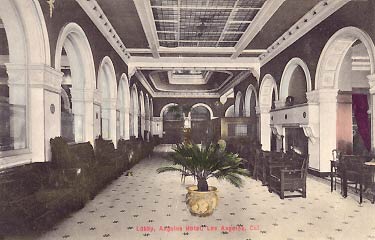
• ...As was the public parlor, or "Reception Room," as they called it.
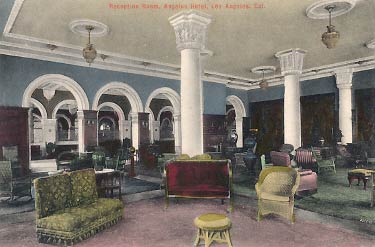
• Rather more private was the Turkish Parlor—positively cozy, I'd say. And I'd blush when I'd say it.

• I picked up a book off one of the tables in the Turkish Parlor, and this old menu which someone had used as a bookmark fell out.
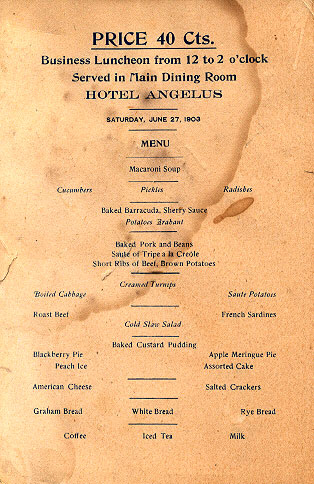
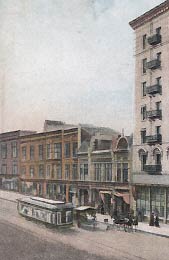 | • Tearing ourselves away from the delights of the Hotel Angelus, we may proceed south down Spring Street's 400 block. Immediately south of the hotel, of which we see a corner in this picture (on the right), are some old shops. |
• As we continue south, we turn and look north several times as we proceed, seeing one of the most photographed (and ever-changing) street scenes in Los Angeles. The building prominently marked as the Hibernian Building is the one we knew in the previous episode as The Union Trust Building, and which is also known as the Braly Building and the Continental Building. Long-term Angelenos will note in the lower picture the sign for Barker Bros. furniture, a company which was prominent in the Los Angeles area for many many years. While we saw that Main Street, with its sprinkling of churches, hotels, and theaters, was diversified in its services, the business of Spring Street is business, businessman's business, financial and soberly professional.
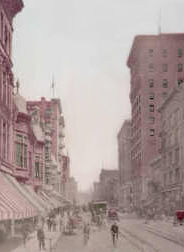 | 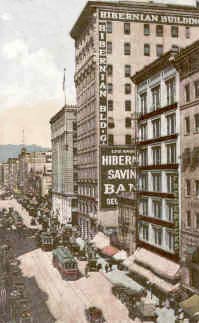 |

| • One last look . . . | 
|
• Before the Union Trust Building, before the Hotel Angelus, this was the scene at the middle of the south 400s block, looking north. We see a bit of the Barker Bros. Furniture wall-sign at right, a sign which would persist into later times (we can see it in one of the views above).
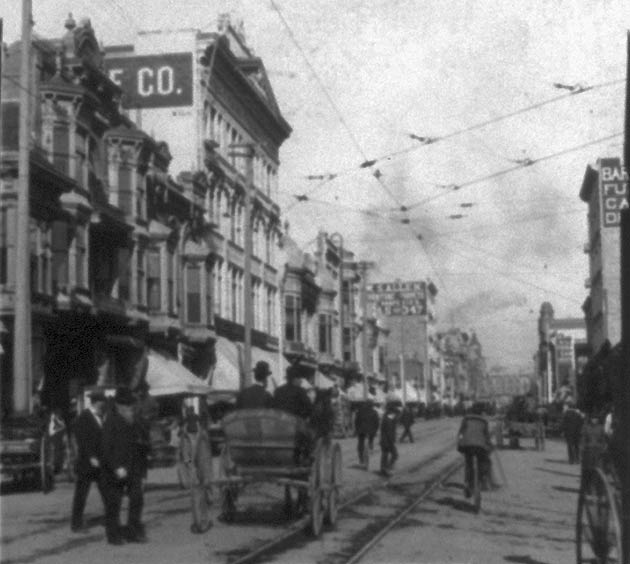
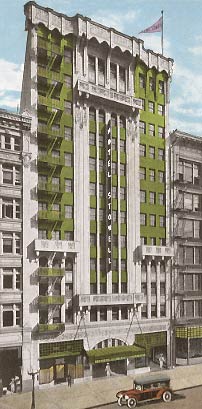 | • Built in 1913, the sleek Hotel Stowell, at 414-416-418 S. Spring St., would fit into the second lot south of the Union Trust Bldg. The Hotel Stowell would later be known as the El Dorado. |
• As the Baby was crying, Mother decided to walk into the hotel and set in the lobby for a while with him. His cries echoed from lobby to hall, and—I had no doubt—up and down the stairwells. "Babies," quoth I, loud enough to be heard by nearby hotel guests, "are an ornament to Society." "Speaking of ornaments to Society," said Charley, "where's the desk clerk? No wonder he's 'tipless'!" Minnie sighed that "he's watching us from behind the bouquets. His nose is large, but the tout ensemble is not unattractive."

• "Aye," grated a Scots voice from a very little man in a very big chair behind us, "your whole ensemble is fairly well a toot, if ye'll ask me!". "Well, sir," said Papa, a bit heatedly, "I didn't ask you, and I won't ask you!". "So there!" said young Frederick Johan. "Have you checked in?" asked a bellhop who appeared from nowhere. "We're not staying here," said Papa. "That's right," said the bellhop as he shooed us away, "you're not staying here—goodbye!"
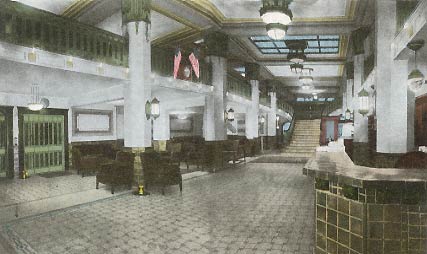
• Soberly professional or not, all those clerks, tellers, executives, salesmen, and customers had to be fed! Another place to eat—the Shanghai Café at 431½ S. Spring Street.
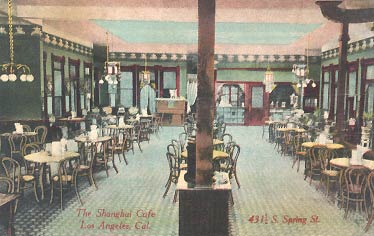
• Though much less photographed, the western face of Spring Street around Fourth Street is no less impressive and interesting. The large white building at the left is The Angelus hotel again; and note the white horse on the right of the view who is enjoying his lunch.
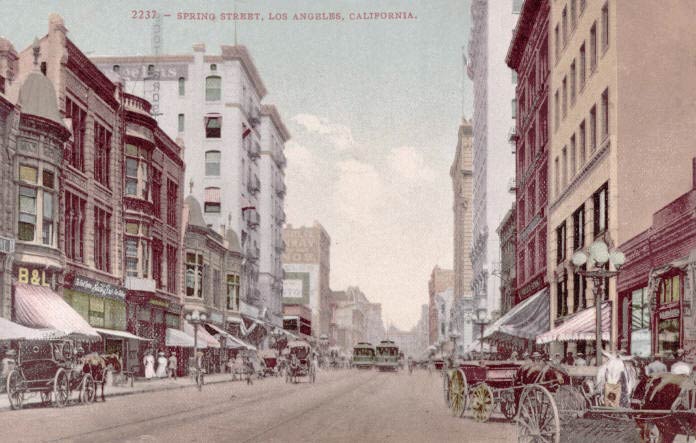
• We look south, to and past the intersection with Fifth Street.
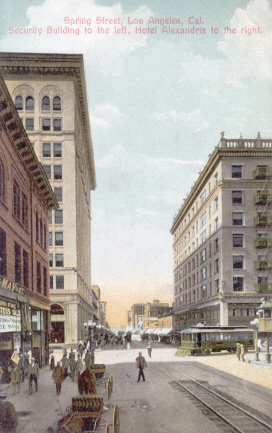
• We reach the corner of Fifth Street, and look north. Do you remember our view of Dr. Burbank's across-the-street neighbors' houses back on Main Street, with its "white building at the upper left corner" of that view? That building—not white in this view—is the building in the near right foreground here.

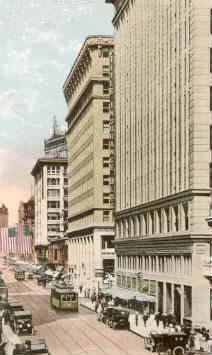 | • From the same corner, we look west. These buildings date from just a few years after the family's visit, having replaced the cozier Victorian-era structures our visitors would have seen. |
| • In one of those Victorian structures, just around the corner from Spring St. at 207 W. 5th St., was The Chocolate Shop. " 'Tis dark as a cellar!," proclaimed Mother as she peered through a window. Young Frederick Johan felt that it would be the perfect place for growing mushrooms. Anna suggested that bats needed a place to call home too. But the baby smelled the chocolate brewing, and seemed to thoroughly approve. | 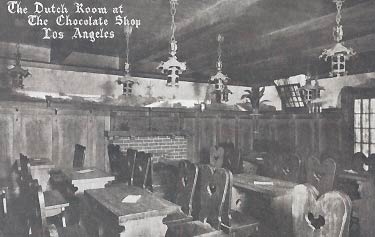 |
• Across the street, the Hotel
Alexandria, built in 1905, commands the southwest corner of Spring and
Fifth...
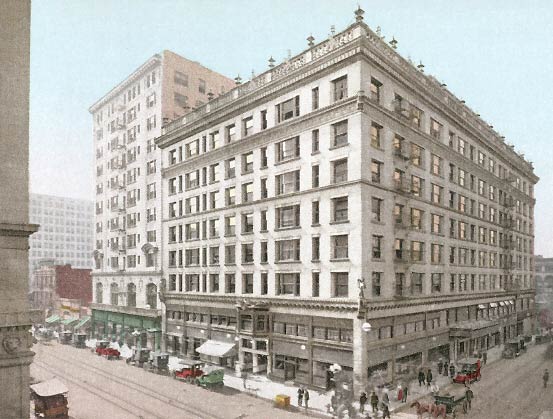
 | • ...While on the southeast corner is
the headquarters of the Security Trust & Savings Bank, built in 1906. |
• With the photographer probably standing atop a convenient building back on Main, we look down on the area of the low 500s on Spring Street, and beyond to Broadway, with Bunker Hill farther yet. This picture dates to a few years before our family visited Los Angeles; for instance, the near building in shadow at the left margin is the Spring Street School, which was soon to be replaced by Mercantile Place, a shopping street which itself was at length replaced by the Arcade Building. At lower right, we see the rear of a building which fronts on Spring Street, bearing the wall-sign "Brent's, the Great Credit House." This is Brent's Furniture, at address 530-532-534 S. Spring Street.

• We walk half a block south
to the mid-500s addresses, and look north towards the corner with Fifth.
On the right, we see an institution still very much with us in Southern
California, Ralphs Groceries.
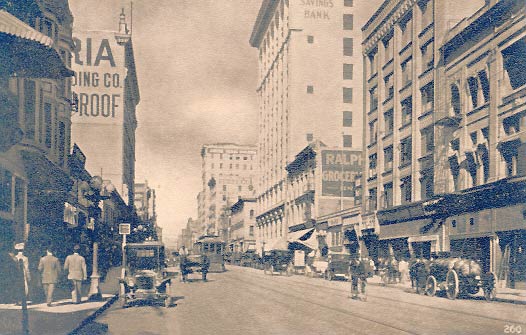
• On the west side of Spring, halfway between Fifth and Sixth Streets, across the street from Ralphs Groceries, we find a little lane leading west to Broadway. This is Mercantile Place, built on the former site of a school, and itself soon to be built over by the Arcade Building (which we'll see when we walk Broadway), in which transformation Mercantile Place became the enclosed arcade between Spring and Broadway. Pictures of Mercantile Place are rare! And rarer yet are pictures of the Spring Street entrance to it. "I found two," declared young Frederick Johan one afternoon at the postcard store. The first one is dominated by the wall-sign for the Hotel Alexandria half a block away; you can make out the entrance to Mercantile Place just beyond the trolley in the foreground.
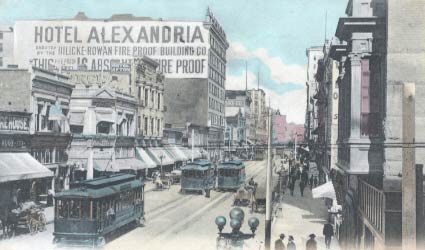
• And the other view is much more festive, showing a parade passing. Beyond the chestnut-colored horses, however, is indeed the Spring Street entrance to Mercantile Place. The Hotel Afton, in the background of this view, can be spotted in several of the previous views; see how many times you can find it.
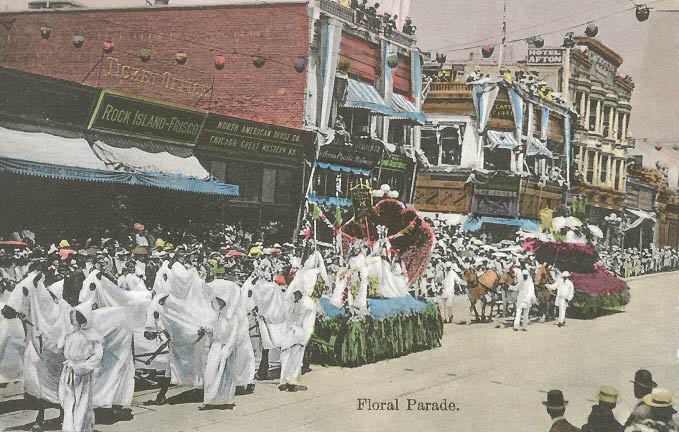
• The Copper Kettle Inn is one of the businesses on Mercantile Place, at address 223; it advertised itself as "the first tea room in Los Angeles." It was a cozy nook at which the ladies of our party refreshed themselves while we men meantime went a few doors down to look at a bank.

• The west face of the upper 500s of South Spring Street. The entrance to Mercantile Place, and Hotel Afton, are at center.
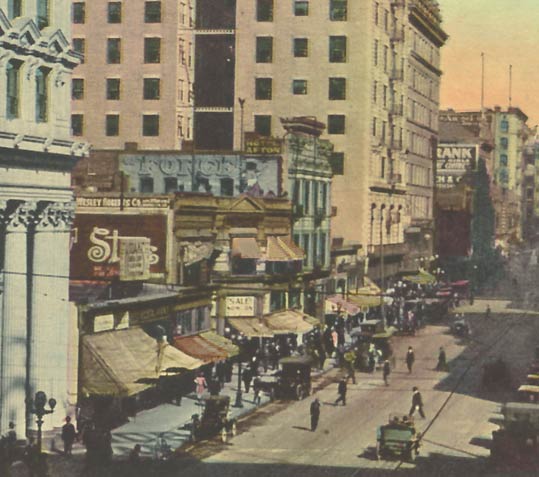
• We come to the corner of
Spring and Sixth, where we take a peek inside one of these financial
institutions on Spring Street, the Los Angeles Trust and Savings
Bank.
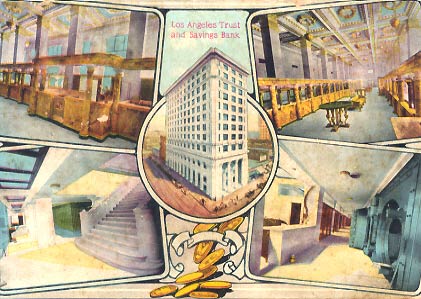
• Papa peeks inside another bank, the Security Trust and Savings Bank. Bankers knew that prosperous-looking banks inspired depositors to have confidence in their institutions, and to want to take part in the institution's prosperity . . . by increasing their deposits.
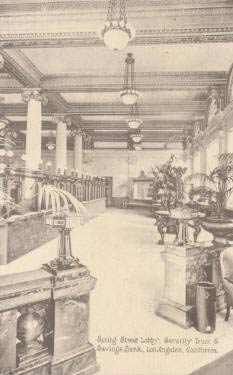
• We all sat down in the waiting area to relax. Papa and Charley were neatly shelling peanuts into the ashtrays when a clerk, tugging his shirtsleeves down over his wrists, asked if he could help us. "Nope," said Papa, "we've pretty much got all these shelled!".
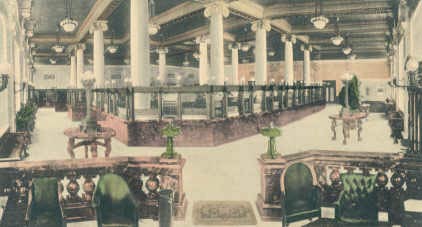
• We step outside the bank and
look west on Sixth Street, the corner of the bank at the right of our
picture. The trolleys are ever-present in busy downtown L.A., two bells
rung each time the cars start, their bells clanging as errant wagons,
bicyclists, pedestrians, horses stray into their path, the trolleys'
wheels rattling against the rails at every curve. The next street west
is Broadway, which we'll be visiting shortly.
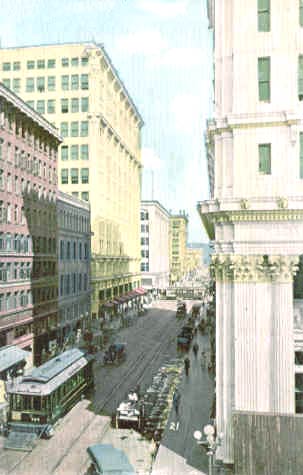
• Having looked west on Sixth Street, now let's go a few yards that direction on Sixth, and then turn and look east along Sixth to the corner of Spring and Sixth and beyond. In this view, the bank has not yet been built. It will be on the lot where the awnings are at left. Kitty-corner to it is the Grosse Building, housing the Southern Pacific Railroad offices, and just beyond that, on Main Street, is the Central Building; back again on this side of Spring, but on the south side of Sixth, is the brick Hotel Hayward, built in 1905.
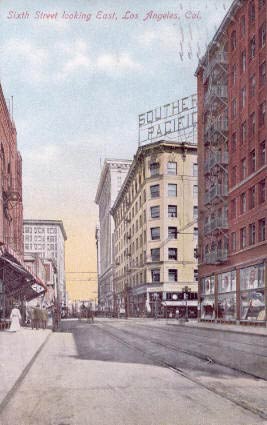
• The Grosse Building, at the southeast corner of Spring and Sixth Sts., was completed in 1906 (and demolished in the latter months of 1957), built by businessman and real estate investor John Grosse, known once upon a time in real estate circles as the "father of the 99-year lease." The building was also known as the Abbot Kinney Building.
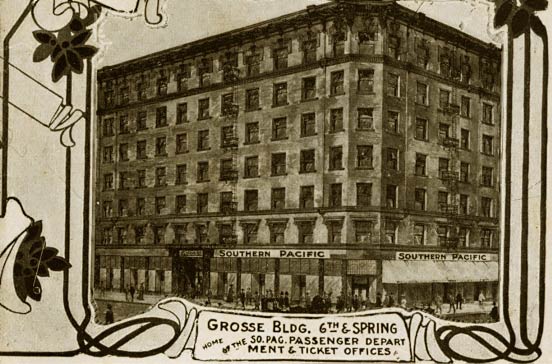
• A better look at the Hotel Hayward, in the Henderson Hayward Hotel Building. The hotel was preceded on this site by the first Ralphs Grocery Store, dating back to 1874, a partnership of the brothers George Ralphs and Walter Ralphs.
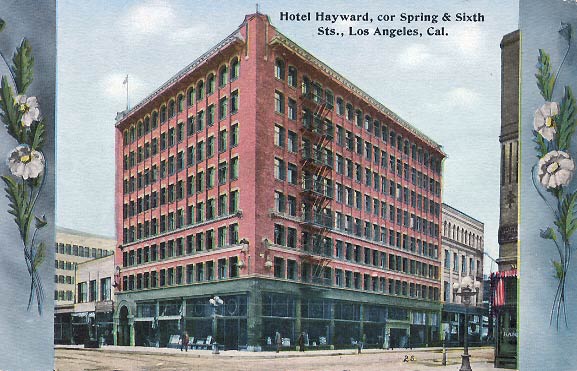
• We begin to walk south
towards Seventh Street. Spring and Seventh! To become the
financial and commercial crossroads of Los Angeles, but at the time of our
visit showing signs of being where downtown starts turning into uptown. We
look back north, at the west side of the street, and see the corner of
Spring and Sixth with the Trust and Savings Bank again, on the far side of
the absolutely fire proof Hotel Hayward.
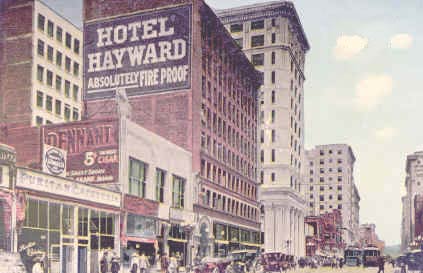
• It was about where the smaller buildings at the left in the above view were where the head office of the California Bank would be built in not too many years.
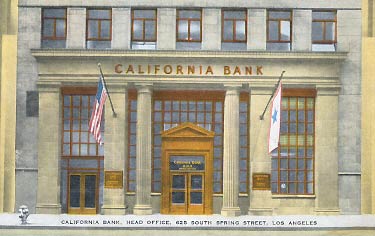
• We get a rare look at the
rough edges of Spring Street in a state of transition. This view is
probably from the roof of the Pacific Electric Building back on Main
Street, looking over the soon-to-be-replaced backyards, small buildings,
and houses on the east side of Spring Street to take in the western face
of the 600 block of Spring, which runs left to right in this picture. The
large tripartite building slightly deeper in the picture and to the left
of center is the Hotel Lankershim at the corner of Seventh and Broadway,
which we shall be coming to in due course. Note the little house at the
northwest corner of Spring and Seventh Streets, just this side of the
Lankershim.
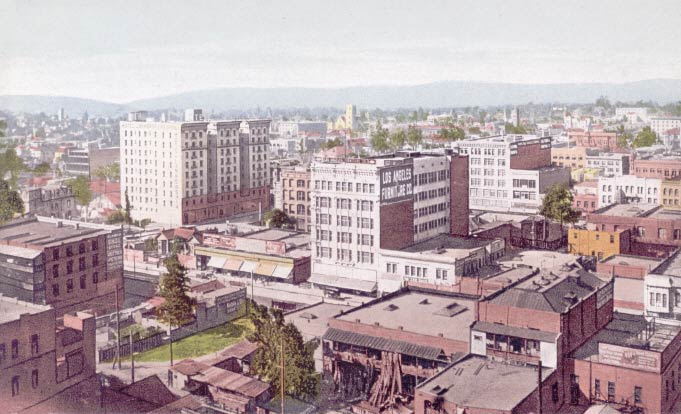
• And now, Spring Street at
Seventh Street, first looking northwards up Spring Street from a little
north of its corner with Seventh. This block of Spring Street is much
built up since our view over the old backyards a moment ago! An older,
modest Victorian-era building sits at mid-right among later Edwardian
construction. But common life is the same no matter what era; a "sample
shoe sale" is being conducted in the awninged building at the extreme
right.
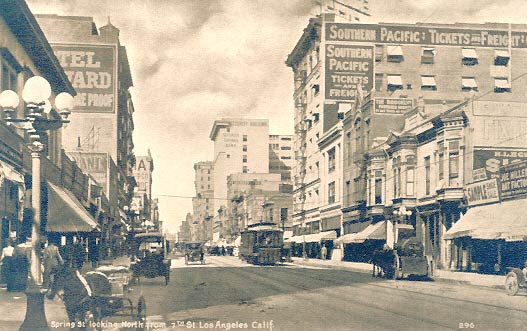
• We look west along Seventh from Spring, seeing the corner with Broadway, and, farther and vaguely, that with Hill. Remember that little house at the northwest corner of Spring and Seventh? It has been replaced by the massive commercial building on the right in this view. Seventh Street—a thriving street ready to take on the business supported by the rich banks on Spring Street!
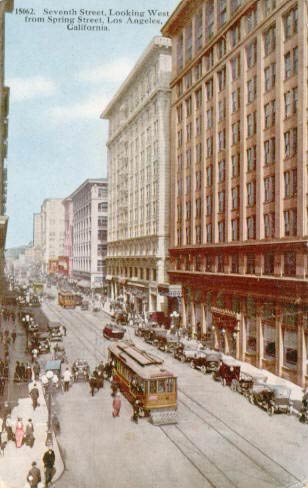
• From west down Seventh Street, towards Broadway, we look back to see the building at the southwest corner of Spring and Seventh, plus a portion of the Hotel Lankershim.
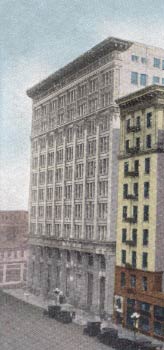
• Like a castle tower to protect the wealth of Spring Street, The Armory stands at attention at the northwest corner of Spring and Eighth. On the bottom floor were the offices of The Evening News. This structure's actual name was the "Copeland Building." The building had at one time served for a short time as premises for the Post Office.
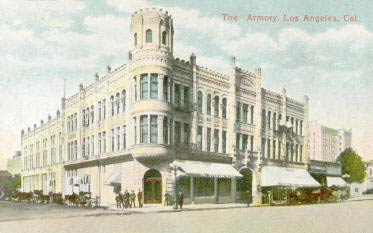
Return to Spring Street part one; or on to New High Street and Broadway part one . . .